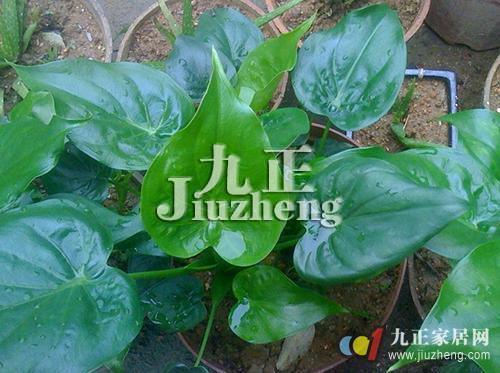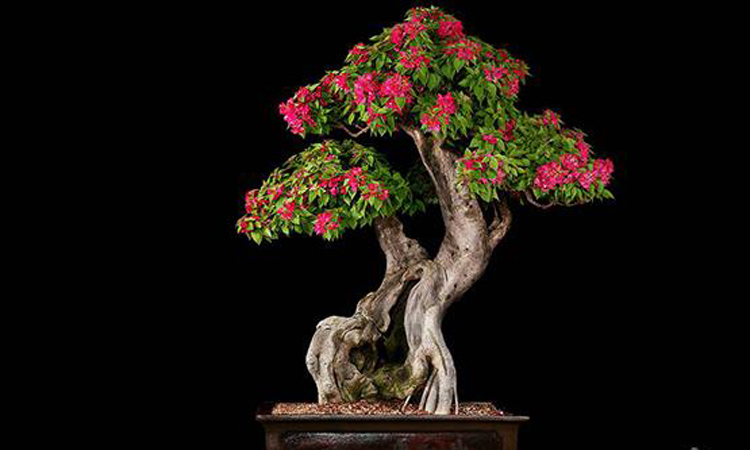How to make the triangular plum bonsai blossom full of trees?
Triangular plum bonsai in maintenance is often due to excessive water and fertilizer, exuberant branches and leaves, resulting in less flowering or non-flowering phenomenon. Although the branches are more ornamental, the ornamental value will be higher if there are flowers. In order to make the triangular plum bonsai blossom full of trees and achieve a better ornamental effect, efforts should be made in sunshine, water and fertilizer and pruning in the maintenance process.
(1) Light. Triangular plum is a sunny and warm plant. Triangular plum bonsai should be placed in a sunny and direct place, so that the branches are stout, the internodes are short, the flower branches and flower buds are full, the number of flowers is large, the flowering period is long, and the flower branches are short.
(2) pruning. Prunus angustifolia has a long growing period, strong germination and long branches. It should be pruned in time to draw long branches, bore branches and cross branches, leaving 3 basal buds, so as to sprout short branches and maintain shape so as to facilitate flowering. Pruning should be carried out in spring and summer, and can not be pruned after mid-August, otherwise it will affect flowering. When blooming, you can pick off the green leaves and show the flowers and leaves.
(3) watering. Buckling water is a step in the formation of flower branches. After stopping pruning in the middle of August, the water supply should be strictly controlled, and each watering should be carried out when the tender buds of the plant leaves are drooping and wilting. The buds are often in a wilting state, which is not easy to grow and can maintain the prototype. Positive watering can be restored when flower bud differentiation of branches and long leaf buds in leaf axils. Do not pour water on the flowers and leaves during flowering to avoid rotten flowers and shorten the flowering period.
(4) fertilization. During the growing period, triangulated plum should apply nitrogen, phosphorus and potassium fertilizer or rotten organic fertilizer frequently, and apply less nitrogen fertilizer to prevent overgrowth. Topdressing after anthesis in spring can increase plant nutrients and promote the growth of new branches. The buds of triangular plum blossom grow on new branches and short branches after autumn. during flowering, thin fertilizer mainly composed of phosphorus and potassium can be applied twice a month to prolong flowering period and increase flower quantity. There is no need to apply fertilizer in winter.
(5) turn over the basin and change the soil. Turn the pot once every 2 years, add sufficient base fertilizer when changing the soil, and cut the root to make the aboveground part of the plant grow in direct proportion to the root, so as to avoid plant malnutrition and affect flowering due to soil consolidation and stagnant water.
How to make the triangular plum bonsai blossom full of trees?
How to make the triangular plum bonsai blossom full of trees?
Triangular plum bonsai in maintenance is often due to excessive water and fertilizer, exuberant branches and leaves, resulting in less flowering or non-flowering phenomenon. Although the branches are more ornamental, for example, the ornamental value of flowers will be higher. In order to make the triangular plum bonsai blossom full of trees and achieve a better ornamental effect, efforts should be made in sunshine, water and fertilizer and pruning in the maintenance process.
(1) Light. Triangular plum is a sunny and warm plant. Triangular plum bonsai should be placed in a sunny and direct place, so that the branches are stout, the internodes are short, the flower branches and flower buds are full, the number of flowers is large, the flowering period is long, and the flower branches are short.
(2) pruning. Prunus angustifolia has a long growing period, strong germination and long branches. It should be pruned in time to draw long branches, bore branches and cross branches, leaving 2 or 3 basal buds to sprout short branches and maintain its shape so as to facilitate flowering. Pruning should be carried out in summer and cannot be pruned after mid-August, otherwise it will affect flowering. When blooming, green leaves can be removed to show flowers.
(3) watering. Buckling water is a step in the formation of flower branches after stopping pruning in the middle of the month, the water supply should be strictly controlled, and each watering should be carried out when the tender buds of the plant leaves are drooping and wilting. The buds are often in a wilting state, which is not easy to grow and can maintain the prototype. Branch flower bud differentiation, leaf axilla long leaf bud, can resume the positive amount of watering, flowering period water should not be watered on the flowers and leaves, in order to avoid rotten flowers and shorten the flowering period.
(4) fertilization. During the growing period, triangulated plum should apply nitrogen, phosphorus and potassium fertilizer or rotten organic fertilizer frequently, and apply less nitrogen fertilizer to prevent overgrowth. Topdressing after anthesis in spring can increase plant nutrients and promote the growth of new branches. The buds of triangular plum blossom grow on new branches and short branches after autumn. during flowering, thin fertilizer mainly composed of phosphorus and potassium can be applied twice a month to prolong flowering period and increase flower quantity. There is no need to apply fertilizer in winter.
(9) turn the basin and change the soil. Turn the pot once every 2 years, add sufficient base fertilizer when changing the soil, and cut the root to make the aboveground part of the plant grow in direct proportion to the root, so as to avoid plant malnutrition and affect flowering due to soil consolidation and stagnant water.
How to make triangular plum bonsai the method of making triangular plum bonsai
Triangular plum bonsai has unique shape, luxuriant branches and leaves, bright colors and high ornamental value. Put a pot of triangular plum bonsai at home, which is very pleasing to the eye. How do you make triangular plum bonsai? Let's take a look at the method of making triangular plum bonsai.
Triangular plum bonsai production is relatively easy, according to the situation of potted triangular plum, can be made into single pole type, double pole type, inclined rod type, curved rod type, horizontal pole type, water drought type, facing water type, cliff type, pagoda type, flower basket type and other different shapes.
The modeling method of triangular plum bonsai is mainly pruning, supplemented by binding. For young trees, flat binding can be carried out according to the needs of modeling, and several triangular plums of different varieties can be planted together according to the needs.

The following editor introduces several methods of making triangular plum bonsai in detail.
Flower basket type: that is, under the premise of trimming the triangular plum into a large plane, each leaving a 500-600mm long branch at the opposite corner of the triangular plum plane, the triangular plum branches are gently bent inward, overlapping at 100-200mm, and tied together to form a flower basket carrying beam, and the basket-like triangular plum bonsai is completed.
Pagoda style: cut off all the side branches of triangular plum, leaving only one or three upright branches upward, if three must be tied or woven together, wait for it to grow to the ideal height, cut off the top, make it sprout lateral buds, according to the interval of 400-500mm, remove the excess buds, forming a multi-tower type.
Cliff style: is the use of binding, so that part of the branches of triangulated plum droop, shaped like a cliff. The cliff-style triangular plum bonsai is finished.
Different kinds of butt grafting method
Several triangular plums are planted in the same basin, the branches are separated by three centimeters, and after normal growth, they are tied up with wires with plastic skin at the appropriate height (depending on the shape). After the triangulated plum growth is fixed, the outer skin of the plant branch joint is cut off with a knife, and the cambium is aligned with the cambium.
The triangular plum branches after the festival are still tied up (the wound is protected from rain and watering), and the thread is removed after the growth is firmly formed. Depending on the following parts can be regarded as the root, can be bent according to their own needs, can also match the stone to form a root boulder. Strengthen the management, grow a lot of branches by connecting the above parts, prune according to the intention, and subtract the excess branches.
Trim trimmed plum branches should not be blindly pruned, there should be an overall bonsai style concept. After pruning the remaining branches for further flat modeling, with the passage of time, the following parts will form a new trunk, but the surface will be rough, will be more vigorous and simple.
- Prev

How to maintain Dizhui Guanyin
The scientific name "Dishui Guanyin" is sea taro. Originally from the tropical rainforest of South Africa, if it is allowed to grow in a moist and warm environment, there will be drops of water on the edge of the leaves, so it is called "dripping Guanyin". When raising dripping Guanyin, we should pay attention to the following aspects: (1) the temperature dripping Guanyin can grow well at an environment of not less than 18 ℃.
- Next

How to make and maintain triangular plum bonsai?
Triangular plum is also known as bauhinia and rhododendron. Its rattan stem grows rapidly, its branches are resistant to pruning, it is easy to form, and the florescence is long. In the southern region, the graceful triangular plum stump is often used to make bonsai. The axillary bud of the new branch is obvious, which is beneficial to pruning, and the old branch lurks many adventitious buds, which has strong germinating power, and can promote the adventitious bud after being cut off.
Related
- Fuxing push coffee new agricultural production and marketing class: lack of small-scale processing plants
- Jujube rice field leisure farm deep ploughing Yilan for five years to create a space for organic food and play
- Nongyu Farm-A trial of organic papaya for brave women with advanced technology
- Four points for attention in the prevention and control of diseases and insect pests of edible fungi
- How to add nutrient solution to Edible Fungi
- Is there any good way to control edible fungus mites?
- Open Inoculation Technology of Edible Fungi
- Is there any clever way to use fertilizer for edible fungus in winter?
- What agents are used to kill the pathogens of edible fungi in the mushroom shed?
- Rapid drying of Edible Fungi

